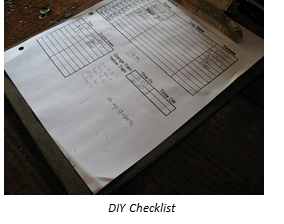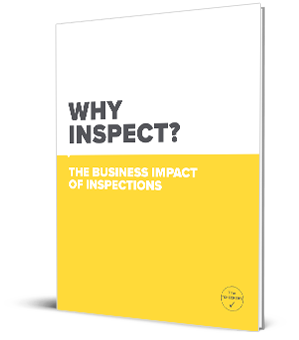Do you have a hodgepodge of equipment inspection checklists in your company?
You’re not alone if you do. It’s common in many industries for businesses to have different inspection checklists for virtually every type of commercial equipment they use.
Why does this happen? Primary because of two reasons:
- Manufacturer checklists. Many manufacturers supply inspection checklists for purchasers and lessors of their equipment.
- Do-It-Yourself checklists. Lacking a manufacturer checklist (or at least a satisfactory one), it’s not difficult at all to create a DIY checklist. All you really need to do is write out the items to check for a particular piece of equipment and then keep making copies (or have copies printed) to use for all similar types of equipment.
A major drawback of both types of checklists is that you naturally end up with a whole bunch of checklist formats floating around.
You Only Need One Format
A danger of DIY checklists is that they won’t include all the items that need to be checked to best ensure safety and optimum operability.
 They’re also often designed with very little thought, frequently resulting in a checklist format that’s more difficult to follow then necessary—as well as unprofessional-looking, which reflects poorly on a company’s commitment to safety.
They’re also often designed with very little thought, frequently resulting in a checklist format that’s more difficult to follow then necessary—as well as unprofessional-looking, which reflects poorly on a company’s commitment to safety.
Manufacturer checklists usually—but not always—include the necessary items to check for safety and performance. However, their checklist formats are often not designed with personnel in mind and are difficult to use.
These issues, though, are essentially irrelevant for companies that understand how equipment inspections can improve safety and lower costs. For these companies, manufacturer and DIY checklists are ruled out from the get-go because multiple checklist formats create confusion and lead to mistakes, reducing the benefit of equipment inspections.
There’s no sense in personnel having to learn new formats every time they inspect a different type of equipment. That wastes time and can be dangerous. Unfamiliarity often results in errors.
The Checker Solution
Our recommendation to any company attempting to improve equipment inspections is to use a single, standardized inspection checklist format for all your equipment inspections.
The caveat is that—while they should all have the same format—every inspection checklist must still be specific to the equipment being inspected.
You can find many vendors who provide inspection checklists that can be used across all your equipment, but they are too standardized. Their format isn’t the only thing standardized—so are the items to check. They don’t contain the necessary detail for each particular type of equipment.
 Our approach at The Checker is to combine a standardized checklist format with equipment-specific checklist detail. We provide professionally designed, consistently formatted inspection checklists for hundreds of types of equipment, with all the equipment-specific detail needed to conduct truly effective inspections.
Our approach at The Checker is to combine a standardized checklist format with equipment-specific checklist detail. We provide professionally designed, consistently formatted inspection checklists for hundreds of types of equipment, with all the equipment-specific detail needed to conduct truly effective inspections.
Based on our decades of experience helping businesses improve workplace safety, The Checker is easy-to-use, with all the necessary items listed in the logical order they should be checked—for each type of equipment. This speeds the inspection process, while the standardized format means no one has to learn new formats, which saves time and avoids mistakes.
Takeaway
Equipment inspection checklists with a standardized format are preferable to a mish-mash of manufacturer and DIY formats. However, the standardization can’t come at the expense of equipment specificity. A checklist such as The Checker is needed.
Learn more about selecting the right inspection checklists by downloading “The Checker Checklist: The Value of Using Checklists,” a checklist of what to look for in checklists!
Top image courtesy of Bossi, Creative Commons.










